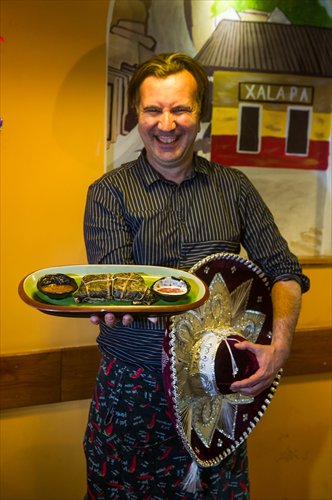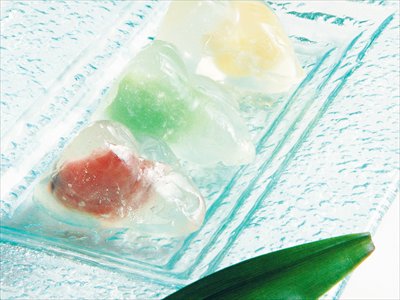Zongzi fever
Meet the sticky rice dumpling’s relatives around the world

Esteban Zottele holds a tamale, the Mexican version of Chinese zongzi. Photo: Li Hao/GT
The first time Huang Kangming found out about Vietnamese sticky rice dumplings was in 2012 when he studied at the University of Social Sciences and Humanities in Ho Chi Minh City.
Green leaves peeled away, the long, rectangular, sticky rice dumplings were sliced up and then fried in a pan and sold as a snack by street food vendors. The tempting fragrance, a mixture of fresh leaves and greasy meat, nostalgically reminded him of zongzi, a traditional Chinese snack people often eat during Dragon Boat Festival.
Dragon Boat Festival, on May 5 in the lunar calendar, falls on June 20 this year. Chinese people celebrate it by racing dragon boats and eating those glutinous rice dumplings wrapped in bamboo and lotus leaves and stuffed with various ingredients like preserved meat, dried egg yolk, dates and red beans.
It's not unlikely that, like Huang, many people have seen zongzi in some other form in other parts of the world. Variations on the dish are rampant, and below, Metropolitan dissects similar snacks in Mexico, Vietnam, and in one Chinese transplant's own American kitchen.
An Asian tradition
The origin of zongzi is related to a legend of the Han people. The food was a symbol to memorialize Qu Yuan, a politician and patriotic poet during the Warring States Period (475BC-221BC), who leaped into a river on May 5, ending his life after his political ambitions were turned down by the King. In order to protect Qu's corpse from being eaten by fish, people threw zongzi into the river to feed the fish.
Today, the tastes of zongzi are divided into two flavors: sweet and salty. In general, people living in the North like eating sugary zongzi - usually stuffed with dates and red beans - while people in the South prefer salty rice dumplings made of meat, bacon and egg yolk.
In Asia, sticky rice dumplings can also be found in North Korea, Japan, Vietnam, Myanmar and the Philippines.
"The preparation methods and eating tradition of Vietnamese sticky rice dumplings are very akin to Chinese zongzi in Guangdong Province and Guangxi Zhuang Autonomous Region," said Huang, who now runs a Taobao store called Aumetoo that sells Vietnamese produce, food and snacks. Based in Honghe in Yunnan Province, his goods are bought from a company at a border city between Vietnam and China. Zongzi sales increase in advance of Dragon Boat Festival, Huang said.
The stuffing of Vietnamese rice dumplings, known as Bánh chung, sold at Huang's store, is made up of meat and green beans. There are two types of rice: white and black. The black rice is dyed with the ash of camphor bark.
"Another characteristic of the Vietnamese rice dumplings is it is wrapped in the leaf of wild Phrynium capitatum," Huang said.
According to Chinese Traditional Medicine, the herb can be used to relieve symptoms of influenza and mouth ulcers.
However, Vietnamese sticky rice dumplings, traditionally, are not the symbolic food eaten during Dragon Boat Festival, but during Spring Festival.
This is similar to the traditions of the Zhuang ethnic minority group in Guangxi. For the Dragon Boat Festival, the Zhuang are more prone to eating ciba (cooked glutinous rice pounded into paste), according to Huang.
In Huang's memory, his mother always got up early to prepare zongzi on the first day of Lunar New Year. "The leaves were freshly plucked from the trees. I stayed around to give her a hand. Then I chopped firewood to cook them."
Huang said his favorite stuffing is chicken, but in Guangxi, meat, green beans, Chinese chestnuts, shrimp, peanuts, mushrooms, ribs and even pig's trotters are popular ingredients for zongzi stuffing.
Bing Qing, a gourmet columnist based in Cupertino at Silicon Valley in the US, said the Vietnamese sticky rice dumpling represents the Southeast Asian gastronomy culture, and she also recommended Filipino rice dumplings.
"The meat dumpling is in a fairly long shape," she said. "Some of the sweet ones, dried into the beautiful color of green from the pandan leaves, are really special."

For the upcoming Dragon Boat Festival, foodies can try exotic flavors of zongzi and make their own at home. Photo: IC
Mexican zongzi or Chinese tamale?
In the West, the most famous food resembling Chinese zongzi is the Mexican tamale.
The tamale is an important staple of Mexican food and dates back thousands of years to the Maya civilization. They are not only eaten in Mexico, but also in countries like Belize, Honduras, Guatemala, Nicaragua and Costa Rica.
At Xalapa near Huguo Temple in Xicheng district, owner Esteban Zottele, originally from Argentina, is proudly selling Mexican food, including tamales, to his customers in Beijing.
"Tamales also have two flavors: sweet and salty, but the flavors differ in different regions and countries," Zottele said.
"All the tamales are made of cornmeal dough and are stuffed with various ingredients, such as beef or chicken, and wrapped in a banana or corn leaf. You can either boil or steam them."
In Zottele's opinion, the tamale is also akin to a Chinese food called nuomiji, literally sticky rice chicken, a traditional dim sum dish popular in southern China.
In Mexico, the tamale is eaten with more than a dozen different sauces, and a popular flavor is the mole sauce, a mixture of chocolate and chilli, according to Zottele. At his restaurant, he mainly sells two types of tamales, chicken and preserved pork.
"It is a fascinating discussion regarding the comparison between the zongzi and tamale," said Zottele.
"Was the zongzi invented before the tamale or was the tamale invented before the zongzi? No one can tell."
Zottele said there were interactions between Mexican and Chinese cultures in ancient times that could have influenced their foods.
During the Qing Dynasty (1644-1911), there was an important marine trade route between Guangdong Province, the Philippines and Mexico. Products including Chinese silverware were traded in Manila, the capital of the Philippines.
"People say that the history of the tamale dates back to 7,000 years ago as people prepared it as food for long expeditions and wars. The history of Chinese people coming to Mexico is about 2,000 years, and the two cultures share some similarities," said Zottele.
"For example, chilli was imported to China from Mexico," he said.
Both the tamale and zongzi are symbolic foods people eat in celebrations at festivals, and Zottele turns to the tamale to cure his homesickness in Beijing. "Tamales are delicious, but can be difficult to cook. When I was a child I loved going to parties because tamales were always served there. When I arrived at the party, I would grab five or six tamales, worrying they would be taken away by others," he said.
Adapted flavors
In order to adapt to Chinese tastes, Zottele uses lotus leaves to replace the corn leaf dumpling wrapper.
"The flavor of the leaf is strong if the tamale is being steamed, and I know Chinese people would be more used to the lotus leaf," he said.
People always adapt and create new food flavors to cater to different demands in different regions, said Bing Qing.
"In the US, Chinese zongzi are not very popular, but some people with Chinese backgrounds started promoting the food by producing organic rice dumplings," she said. "They make rice dumplings without gluten and MSG and adapt flavors to different nations of people."
But for Bing Qing, DIY zongzi for the upcoming Dragon Boat Festival is a family tradition. She prepared "crystal dumplings," originally created by American coffee chain Starbucks, to share with family members and friends.
"Crystal zongzi look transparent and very beautiful," she said. "It's low in calories and not greasy. It tastes like you are eating jelly."
Make your own crystal dumplings in five steps
1 Gather 50 grams of sugar, 5 grams of crystal cake powder (sweet potato flour, custard powder, corn starch), 210 milliliters of corn syrup, and 500 milliliters of water
2 Mix the power and sugar and syrup together, and boil them with the water
3 Pour the mixture into molds lined with plastic wrap
4 Put fruit (like cherries) into the mixture and wrap it up
5 Refrigerate for 30 to 60 minutes